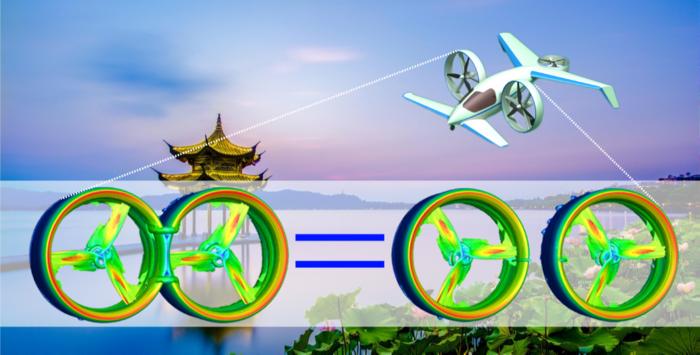In the realm of aeronautics, a significant breakthrough has emerged concerning ducted propellers, which have long been recognized for their potential in the field of electric Vertical Take-Off and Landing (eVTOL) aircraft. A group of researchers led by Professor Wu has developed an innovative analytical framework that standardizes the evaluation of various ducted propeller configurations, paving the way for greater efficiency and performance in low-altitude aircraft. This research addresses a critical gap in the industry, as engineers have faced challenges when trying to optimize multi-propeller systems due to a lack of standardized criteria for comparing different designs.
Ducted propellers are effectively propellers enclosed within a cylindrical housing, which yields multiple advantages, including improved propulsion efficiency, reduced noise, and enhanced safety as compared to traditional open rotors. However, the inherent complexity of distributed propeller systems makes it difficult to establish a coherent method for measuring performance across various configurations. This difficulty has hampered the design and optimization of aircraft that utilize such propulsion systems, restricting innovations in urban air mobility.
The analytical criteria for equivalent ducted propellers developed by Professor Wu’s team strike at the heart of these challenges. By using fundamental principles of momentum and energy conservation, they introduced a universal metric that allows engineers to assess the aerodynamic performance of diverse ducted configurations—be it single ducts housing one or two rotors, or dual-duct arrangements—with accuracy and fairness. This new yardstick has demonstrated that different multi-rotor setups can achieve comparably high levels of thrust using identical power inputs, fundamentally validating the newly proposed criteria.
One of the most compelling outcomes of this research is its implications for size and weight reduction in ducted propeller systems. Numerical simulations revealed that systems employing multiple rotors can be considerably more compact than their traditional counterparts. For instance, a dual-rotor single-duct design was shown to be around 32% smaller in volume and 35% lighter in mass compared to a single-rotor setup, while maintaining similar thrust capabilities. Such size and weight savings are vital for eVTOL aircraft, where every gram of weight has a proportional effect on payload capacity and flight duration.
Furthermore, this study underscored the importance of “rotational consistency” within systems that utilize multiple propellers confined to a single duct. The research found that the way these propellers rotate in relation to one another significantly influences their collective performance, particularly at lower speeds. Inconsistent propeller rotation can disrupt airflow patterns, ultimately causing a considerable loss of thrust and inviting instability in the system. However, consistent rotation fosters streamlined airflow, enhances interaction between the duct and propellers, reduces energy losses, and boosts overall thrust capabilities and stability—a critical finding for engineers aiming to optimize the control strategies inherent in complex propulsion systems.
The ramifications of this study are extensive, offering a much-needed mechanism for standardized evaluation in an industry rife with complexity. The researchers have provided invaluable insights into how rotational parameters can be leveraged to improve thrust efficiency while safeguarding system stability. The potential for practical application is vast; by employing the established standards, engineers can develop more effective, reliable, and compact ducted propeller systems that shift the future of urban air mobility from mere speculation to tangible progress.
Considering the rapid advancements in air mobility technology, this research serves as a vital stepping stone toward making advanced eVTOL vehicles not just feasible but also practical for everyday use. With urban air travel potentially on the horizon, this study represents a call to action for ongoing research and development in this arena. It is a moment for the aerospace industry to rally, as the findings from Professor Wu’s team offer the prospect of increasing efficiency while addressing environmental concerns—a key consideration as cities around the world prepare for the integration of air transport into their infrastructure.
Looking into the future, the researchers plan to expand upon this initial framework by further exploring the effects of varying multi-rotor configurations, refining rotational strategies, and trying out advanced optimization techniques. Their work not only enhances the theoretical landscape of ducted propeller designs but also aims to deliver practical solutions that could lead to the creation of aircraft characterized by high efficiency, safety, and environmental consideration.
Thus, the journey of engineering better ducted propeller systems is just beginning, propelled by a clear vision of accessible urban air travel. With continuous efforts to unravel the intricacies of aircraft design and operation, the work of Professor Wu’s team could herald an era of unprecedented transformation in the transportation sector. The challenges that lie ahead in the pursuit of developing advanced air mobility solutions are enormous, yet with the opening of new pathways through this innovative research, the mountains of obstacles appear surmountable.
In conclusion, it is clear that the landscape of aeronautics is steadily evolving. The analytical criteria introduced by this research not only set a foundation for future advancements but also invite other innovators to engage with complex components of aircraft design. As urban landscapes grow more densely populated and the demand for efficient transportation options rises, the role of ducted propellers will become increasingly critical. This study is a substantial leap towards the dream of creating safe, efficient, and environmentally friendly aircraft that may soon dominate the skies above our cities.
Subject of Research: Ducted Propellers and their Aerodynamic Characteristics
Article Title: Numerical Investigation on Aerodynamic Characteristics of Equivalent Distributed Ducted Propellers
News Publication Date: 14-Mar-2025
Web References: DOI link
References: Zeyu Li, Jianghao Wu, Bairui Pei, Long Chen, Zhengping Zou, Haiying Lin. Numerical investigation on aerodynamic characteristics of equivalent distributed ducted propellers. Chinese Journal of Aeronautics, 2025, 38(6): 103487.
Image Credits: Haiying Lin, Beihang University
Keywords
Ducted Propellers, eVTOL, Aerodynamics, Urban Air Mobility, Propulsion Efficiency, Thrust, Aircraft Design, Energy Conservation, Propeller Systems, Standardized Evaluation.




